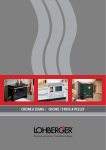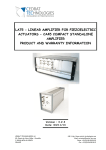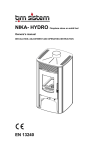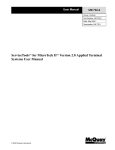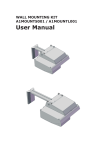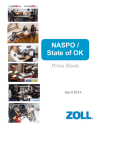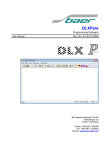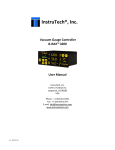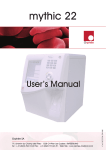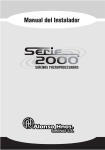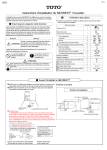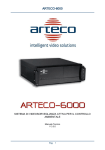Download Intell-Lab™ IL 0.0001 g PB 0.001 g PB 0.01 g Service Manual
Transcript
A Higher Level of Precision… A Higher Level of Performance Intell-Lab™ IL 0.0001 g PB 0.001 g PB 0.01 g Service Manual Problem and solution for balances model IL-0.0001, PB-0.001 and PB-0.01g Fault Possible cause Balance not stable. Dirt inside the magnet. Service Table Display damage No power supply. No connection display. No connection keyboard No bottom keyboard Mechanical group service.(Clear the magnet) Mechanical group service.(change flexures) Mechanical group service Function linearity Check_main_board_signals_EM C Change_display Check_main_board_signals_EM C 26 poli poli. Change cable 14 Change keyboard Corner load not correct Parallelogram guide damage Corner load not regulated Change parallelogram guide Corner load EMc Linearity not correct Regulated linearity error. Verify bandy flexures Function_linearity_ Mechanical group service Bandy flexures. Display doesn’t move from zero Display doesn’t work correctly Keyboard fail/ At power on if balance beeps. Mechanical group damage Error linearity A/D converter fail Mechanical group service IL-0.0001, PB-0.001, PB-0.01g For Model IL0.0001 1. REMOVE THE BALANCE TOP COVER WITH DRAFTSHIELD (REMOVE ONE SCREW Fig.1 AND FOUR SCREWS UNDER THE BALANCE Fig2 Fig.1 2. Fig.3 Fig.2 REMOVE THE COVER SHIELD OF MECHANICAL GROUP, Fig.3 For Model PB-0.001 1. REMOVE THE BALANCE TOP COVER (REMOVE ONE SCREW Fig.1 AND FOUR SCREWS UNDER THE BALANCE Fig2) 2. REMOVE THE COVER SHIELD OF MECHANICAL GROUP (REMOVE FOUR SCREWS Fig.3) Fig.3 For Model PB-0.01 1. REMOVE THE BALANCE TOP COVER (REMOVE ONE SCREW Fig.1 AND FOUR SCREWS UNDER THE BALANCE Fig2) Fig.1 2. Fig.2 REMOVE THE COVER SHIELD OF MECHANICAL GROUP (REMOVE FOUR SCREWS Fig.3) Fig.3 For all Model PB-0.01, PB-0.001, IL-0.0001 1. REMOVE THE DISPLAY BOARD (REMOVE FOUR SCREWS Fig.1) AND COVER SHIELD OF MAINBOARD (REMOVE FIVE SCREWS Fig2) 2. REMOVE THE CABLE OF OPTICAL GROUP (Fig.3) AND THEN REMOVE THE MECHANICAL GROUP (REMOVE THREE SCREWS UNDER THE BALANCE Fig.4) Fig.3 Fig.4 Disassembly group for all Model PB-0.01, PB-0.001, IL-0.0001 The mechanical group is the same for all model except for: dimension of springs dimension of spacers cone 1. Take jigs for the moving pillar (two screws M5x20mm and two spacers) 2. Insert the screws in the holes (left and right) of the moving pillar 3. Insert the spacers in the space between moving pillar and monobloc (left and right) 4. Fix the screws left and right 5. Turn up side down the group 6. Take tool n°7 7. Remove the four screws of bottom parallelogram guide 9. Remove parallelogram, handling it carefully 9. Turn the group up again 10. Remove the two ’ cone support s screws 11. Remove the cone support 12. Take tool n°7 13. Remove the four screws of top parallelogram guide 15. Remove the top parallelogram guide, handle it carefully 17. Take tool n°7 17. Remove baricenter from below the monobloc 18. Take the jigs for vertical spring (n°2 screws M4x10mm, n°1 screw M4x22mm, n°1 clamping plate whit hole and n°1 tool to fix the lever) 19. Position the jig on the moving pillar 20. Insert two screws in the holes of moving pillar and fix them. 21. Insert the clamping plate. 23. Insert screw and fix clamping plate with tool n °3. 24. Remove top screws of vertical spring, with tool n°3 26. Remove spacer lever for: 0.0001g= n°1x7mm,n°1x0.5mm 0.001g = n°1x4mm. 0.01g = 0mm 27. Remove screw of plate. 28. Remove screws of fixed jig to moving pillar. 30. Remove jigs for vertical spring. 28. Remove the screws and spacer fixed jigs of moving pillar. 29. Remove moving pillar 30. Remove screws of fixed vertical spring with tool n°3 Spacer of moving pillar for: 0.0001g = n°1x0.5mm 0.001g = n°1x4mm 0.01g = n°1x7mm, n°1x0.5mm Vertical spring: 0.0001g = Vertical spring 0.5/0.10mm 0.001g = Vertical spring 0.5/0.10mm 0.01g = Vertical spring 1/0.12mm 31. Take jigs for the lever (n°4 screws M4x19mm, n°1 tool for fixing the lever) 33. Put the jig on the lever 34. Insert two screws in to monobloc and two in to lever. 35. Fix the screws: first the top ones then the bottom ones 35. Unsolder the gold wires. 36. Remove n°4 screws that the fix fulcrum flexures using tool n°7. 38. Remove the fulcrum flexures Fulcrum flexures: 0.0001g = Fulcrum flexures 0.5/0.09mm 0.001g = Fulcrum flexures 0.5/0.09mm 0.01g = Fulcrum flexures 0.51/0.10mm 38. Unsolder the wire of sensor 39. Remove n°3 screws that fix the magnet cover 40. Remove magnet cover. 42. Remove n°5 grains (n°2 left and rigth side and n °1 at rear side) that fix the magnet. 42. Remove magnet from below the monobloc Now if you need to remove the lever to change the coil or lever then follow points from A to E, otherwise go to point 43. A. Remove jigs for lever (Remove n screws). C. Remove the lever. C. Unsolder the wire of coil. D. Remove n°2 screws and spacer of coil that fix the lever to coil. 43. Clean the magnet with air 44. Take a taper and precision tweezer. 45. Put taper on the top of precision tweezer so that adhesive side is outside. 46. Clean deeply the magnet turning precision tweezer around of magnet. Now you can start assemble the mechanical group 47. Take jigs for level (n°4 screws M4x19mm, n°1 tool for fixing the lever). 48. Insert two screws in to monobloc and two in to lever. 49. Insert magnet from below into monobloc 50. Put on the cover of magnet (do not fix it). 51. Solder the gold wires on the lever. 52. Put fulcrum flexures with four screws, and fix them.(Position the flexures with circular hole UP) Fulcrum flexures: 0.0001g = Fulcrum flexures 0.5/0.09mm 0.001g = Fulcrum flexures 0.5/0.09mm 0.01g = Fulcrum flexures 0.51/0.10mm 54. Remove the jig for the lever. Spacer movin pillar for: 0.0001g = n°1x0.5mm 0.001g = n°1x4mm 0.01g = n°1x7mm, n°1x0.5mm Vertical spring: 0.0001g = Vertical spring 0.5/0.10mm 0.001g = Vertical spring 0.5/0.10mm 0.01g = Vertical spring 1/0.12mm Clamping plate 54. Insert two screws (M4x22mm) with washer. 55. Insert the spacer on moving pillar, and vertical spring 57. Insert Clamping plate, but do not strongly fix the screws. 57. Take the jig for the vertical spring. 59. Take jig spacer for moving pillar 61. Insert screws in the holes (left and right) of moving pillar 62. Insert spacer between moving pillar and monobloc (left and right) 63. Put the jig spacer under the left side of moving pillar and fix the screw on left. 64. Put the jig spacer under the right side of moving pillar and fix the screw on right. 66. Center the hole of the vertical spring with the hole of the lever. 68. Fix the two screws of bottom vertical spring 70. Insert spacer of lever for: 0.0001 g=n °1 x7mm,n °1 x0.5mm 0. 001g = n° 1x4m m . 0. 01g = 0mm 71. Insert top screws of vertical spring, and fix them using tool n°3 73. Remove the cover of magnet 75. Insert jigs for centering the lever 77. Fix the screws of coil. 79. Remove the screw that fix the clamping plate of jig. 81. Remove screws that fix the jig for vertical spring. 83. Remove jig for vertical spring. 63. Put the top parallelogram guide onto the group. 64. Insert the jigs for centering the parallelograms 65. Insert four top screws of parallelogram guide and fix them. 76. Put cone support on the moving pillar ’ 78. Insert two cone support s Screws and fix them 80. Solder the wire of temperature sensor. ( I m p o r t a n t : do not invert the wires) 79. Put the bottom parallelogram guide on bottom of the group. 81. Insert the jigs for centering parallelograms 83. Insert four screws of parallelogram guide and fix them. 85. Turn up the group 87. Connect the group to the main board. 84. Turn on the balance and center the lever. (when the balance is turned on, the lever must exactly be centered in the window). 85. Fix the screws 86. Fix the mechanical group in the bottom case. 87. Check the main board signals. 88. Regulate the corner load error of the balance. 89. Check and regulate linearity of balance. Au t o c a l i b r a t i o n s ys t e m m o t o r g r o u p Corner load regulation for model EMC IL-0.0001, PB-0.001, PB0.01g For Model IL-0.0001 1. REMOVE THE COVER WITH DRAFTSHIELD (REMOVE ONE SCREW Fig.1 AND FOUR SCREWS UNDER THE BALANCE Fig2) 2. REMOVE LABELS ON THE HOLES (Fig 3) Fig.3 3. CONNECT KEYBOARD, PUT THE PLATE WIHT WINDSHIELD AND TURN ON THE BALANCE. (KEEP WARM UP FOR 20 MINUTES Fig 4.) Fig.4 For Model PM-0.001 1. 2. REMOVE THE CAPS (Fig.5) PUT THE PLATE AND TURN ON THE BALANCE. (KEEP WARM UP FOR 20 MINUTES.) Fig.5 For Model M0.01 1. 2. REMOVE DISK UNDER THE PLATE.(REMOVE FOUR SCREWS Fig.6) PUT THE PLATE AND TURN ON THE BALANCE. (KEEP WARM UP FOR 20 MINUTES.) Fig.6 For all Model PB-0.01, PB-0.001, IL-0.0001 TOOL NUMBER 8 FOR CORNER LOAD RAGULATION SCREW FOR CORNER LOAD REGULATION 1. PUT THE WEIGHT (1/3 OF MAX RANGE) TO CHECK IN THE CENTER OF THE PLATE, AND PRESS TARE. 2. MOVE THE WEIGHT IN THE POINT 2A, READ AND WRITE DOWN THE VALUE. 3. MOVE THE WEIGHT IN THE CENTER AND PRESS TARE. 4. MOVE THE WEIGHT IN THE POINT 2B, READ AND WRITE DOWN THE VALUE. 5. TAKE THE TOOL AND REGULATE AS ILLUSTRATED IN THE TABLE BELOW IF THE CORNER 2A POSIT IVE(+) THEN TURN THE TOOL CLOCKWISE IF THE CORNER 2A NEGATIVE(-) THEN TURN THE TOOL ANTICLOCKWISE (SCREW A) (SCREW A) IF THE CORNER 2B POSITIVE(+) THEN TURN THE TOOL ANTICLOCKWISE IF THE CORNER 2B NEGATIVE(-) THEN TURN THE TOOL CLOCKWISE (SCREW B) (SCREW B) Attention: if the corner opposite can not corrected, check if the mechanical group is ok. PROCEDURE TO LINEARIZE EMC BALANCES IL-0.0001, PB0.001, PB-0.01g RELEASE R2.xx For model with four point of linearity 1. 2. 3. 4. 5. 6. Switch on balance. After 30 min press ON/OFF button. Press sequentially buttons ON/OFF - CAL – CAL. You will see "Lin" on display, press ENTER to confirm.. The display shows on the left number “1” wait stability and after 3 seconds press CAL to confirm. When the balance and show number 2 on the left put first weight, (table weight for linearity) wait stability and after 3 seconds press CAL to confirm. Put second weight, wait stability and after 3 seconds press CAL to confirm. Put third weight, wait stability and after 3 seconds press CAL to confirm. After this point, press CAL and keep it pressed until the display show number 3 on the left. Then press ON/OFF to return to weighing mode. Calibrated the balance and check linearity. Attention: if you forget point 9 the data will not be stored and you will have to do again the linearization procedure. For model with seven point of linearity Switch on balance. After 30 min press ON/OFF button. Press sequentially buttons ON/OFF - CAL – CAL. You will see "Lin" on display, press ENTER to confirm.. The display shows on the left number “1” wait stability and after 3 seconds press CAL to confirm. When the balance and show number 2 on the left put first weight, (table weight for linearity) wait stability and after 3 seconds press CAL to confirm. 7 . Put second weight, wait stability and after 3 seconds press CAL to 8 . confirm. Put third weight, wait stability and after 3 seconds press CAL 9 . to confirm. Put fourth weight, wait stability and after 3 seconds press 10. CAL to confirm. Put fifth weight, wait stability and after 3 seconds 11. press CAL to confirm. Put sixth weight, wait stability and after 3 12. seconds press CAL to confirm. 13. After this point, press CAL and keep it pressed until the display show number 3 on the 14. left. Then press ON/OFF to return to weighing mode. 15. Calibrated the balance and check linearity. Attention: if you forget point 9 the data will not be stored and you will have to do again the linearization procedure. 1. 2. 3. 4. 5. 6. For model with twelve point of linearity Switch on balance. After 30 min press ON/OFF button. Press sequentially buttons ON/OFF - CAL – CAL. You will see "Lin" on display, press ENTER to confirm.. The display show on the left number “1” wait stability and after 3 seconds press CAL to confirm. When the balance and show number 2 on the left put first weight, (table weight for linearity) wait stability and after 3 seconds press CAL to confirm. 7 . Put second weight, wait stability and after 3 seconds press CAL to 8 . confirm. Put third weight, wait stability and after 3 seconds press CAL 9 . to confirm. Put fourth weight, wait stability and after 3 seconds press 10. CAL to confirm. Put fifth weight, wait stability and after 3 seconds press 11. CAL to confirm. Put sixth weight, wait stability and after 3 seconds 12. press CAL to confirm. Put seventh weight, wait stability and after 3 13. seconds press CAL to confirm. Put eighth weight, wait stability and after 14. 3 seconds press CAL to confirm. Put ninth weight, wait stability and 15. after 3 seconds press CAL to confirm. Put tenth weight, wait stability 16. and after 3 seconds press CAL to confirm. Put eleventh weight, wait 17. stability and after 3 seconds press CAL to confirm. Put twelfth weight, 18. wait stability and after 3 seconds press CAL to confirm. 19. The balance goes automatically in stand-by status ; press ON/OFF to return to weighing mode. Calibrated the balance and check linearity. 1. 2. 3. 4. 5. 6. Clear the linearit y and calibration value: 1. Switch on balance. 2. Press sequentially buttons ON/OFF - CAL – CAL. 3. You will see "Lin" on display, press ENTER to confirm.. 4. The display show on the left number “1 ” press MENU and keep it pressed until the display shows CLEAR. MARK " M " 0.0110.l g ODOIO E MORELLO PORTATA( L.inearita' fpBsi RISOLUZ.4gti lassB FL S 22C LCCC . L ' / C 2D v.v v.' v.v v -v vvv C - ' EC 3CC EC C-'KCg-3CCc-ELCCc v.' -. . ' /2C2D B_" I' i2v2C . 6_= = 1= ` :'2vv20 BL___- V55 C20 BL f E VE2C2O 6L- '.E2 `.'v2v2C -, E2CC u c2v u 22v 2vvv v. v. v.v v.' -. „ „u -2vuuu-3vuuu-vuuu-uvuuu-uvuc v v 2 v v v '?v C-'ECCg-3=c-LECCc E- L „ ' E2CC V V V 62CC V ^ y C. CC -3 CC -. , CC u ?u"u ' L 2 ~ v u u 3 2 v u u ~vuuu ~?vu~ . .,v g - 2 C C C -3CCCc-LCCCc-ECCCc-6 v.' CCCc TOP RAY 0.00l g =DICE MODE LLO PORTATA4g; RISOLUZ.g } Lin~arita' fpEei Sa :a D_r TOP RAY v.-- Internal calibration In these balance models there are 4 calibration modes: From display zero condition, press and keep pressed the MENU button until the acoustic alarm is over, then release the button. The message “unitS” will be visualized on display, press then MENU button until you visualize “Calib” on display. Press PRINT to confirm. 1. Select the calibration mode you wish by pressing MENU button in sequence: AUT-CAL: auto calibration I-CAL: internal calibration E-CAL: external calibration TEC-CAL: technical calibration 2. Press PRINT button to confirm “AUT-CAL”, “I-CAL”, “E-CAL”. To confirm “TECCAL” keep pressed the PRINT button until the acoustic alarm is over. 3. After selection, the balance returns to calibration menu. Press and keep pressed MENU button until the acoustic alarm is over, then release the button. Balance is again ready for weighing operations. Technical calibration (TEC-CAL) This function allows to store the value of internal reference mass whenever checking or assistance actions require it. 1. After having selected the TEC-CAL calibration mode, press CAL button at empty pan. It will be displayed “CAL”. 2. When the value of calibration weight start flashing on display, load the weight on to the balance pan. 3. Wait the acoustic alarm and that the displayed calibrated weight value stops flashing, then unload the weight from balance pan. 4. When string “0.000” is displayed continuously, then press and keep pressed the PRINT button. This starts the internal weight value automatic acquisition and store. During the acquisition cycle, the display will show “TEC-MEM”. 5. After having stored the value of internal calibration weight, balance returns to normal weighing conditions. 6. Return to calibration menu as described at paragraph 6.2 and set the desired calibration mode: internal, automatic or external.. ATTENTION : this procedure must be effected only using E2-class reference masses. Change main board EMC series IL-0.0001, PB-0.001, PB-0.01g 1. REMOVE THE COVER OF BALANCE.(REMOVE THE SCREW ON THE TOP, AND FOUR SCREWS ON THE BOTTOM. 2. REMOVE THE DISPLAY AND THE BOARD SHIELD. 3. DISCONNECT POWER SUPPLY, OPTICAL SENSOR CONNECTOR, RS232 CONNECTOR, KEYBOARD CONNECTOR, DISPLAY CONNECTOR, GEAR CONNECTOR, AND UNSOLDER SIGNAL RESISTOR. 4. REMOVE SCREWS FIXED MAIN BOARD AND SINK. NOW YOU CAN ASSEMBLE THE NEW MAIN BOARD. 5. CONNECT, POWER SUPPLY, OPTICAL SENSOR, RS232, KEYBOARD, DISPLAY, GEAR CONNECTOR AND SOLD SIGNAL RESISTOR. 6. FIX THE DISPLAY AND THE BOARD SHIELD. 7. FIX THE COVER OF BALANCE. 8. CHECK AND REGULATE CALIBRATION LINEARITY AND INTERNAL CALIBRATION(TECH CAL). IMPORTANT: When you order a new MAIN BOARD, please tell us the reference code printed on label on board shield (fig.1) Check of main board signals EMC series IL-0.0001, PB-0.001, PB-0.01g. Display RS232 Connector Signal Resistor Keyboard Connector Tp8 From –2,4V (with unload plate) To +2,4V (with maximum range on plate) Gear connector Tp6 + 3.3 V Power 24 v AC Tp2 Tp7 AGND Reference 5V Tp4 - 12 V Tp3 Tp1 Tp5 + 12 DG +5 Spare parts for balance EMC model IL-0.0001, PB-0.001,PB0.01g M 0.0001 g/M 0.000 1ig CODE DESCRIPTION A7 13 ALLUMINIUM INTERNAL CASE A7 12 MECHANICAL GROUP SHIELD A7 11 MAIN BOARD SHIELD A7 19 ADJUSTABLE FEET PLASTIC CASE A538 HOOK CAP A73 1 A503 DUST COVER ANALITICAL LEVEL BUBBLE A720 KEYBOARD BEL ADT7 124 S3 14 MAIN BOARD BILMSP430_427_REV2.1 ANALITICAL S284 S304 OPTICAL SENSOR DISPLAY BOARD DISP_LCD_ADT7 1 24_REV 1.1 IMAGE ONLY M0.0001ig CODE DESCRIPTION M642 INTERNAL WEIGTH 200g I MAGE PB-0.001 g / PB-0.001 g PB-0.001 g / PB-0.001 g A712 MECHANICAL GROUP SHIELD CODE DESCRIPTION A7 11 MAIN BOARD SHIELD A7 13 ALLUMINIUM INTERNAL CASE A503 LEVEL BUBBLE S3 13 MAIN BOARD MSP430_427_REV2.1 6K S284 OPTICAL SENSOR S304 DISPLAY BOARD DISP_LCD_ADT7 1 24_REV 1.1 E3 18 LCD ADT7 124 S310 CABLE 14 PIN FOR KEY CONNECTING S3 11 CABLE 26 PIN FOR DISPLAY CONNECTING I MAGE M0.01g/M0.01ig A720 KEYBOARD BEL ADT7 124 CODE DESCRIPTION E493 CABLE WITH DC PLUG E748 CABLE WITH RS232 CONNECTOR E496 CABLE WITH SENSOR TEMPERATURE M620 MONOBLOC M109 LEVER WITH FLAG M9 12 COIL M20 1 MOVING PILLAR I MAGE M0.01g/M0.01ig A713 ALLUMINIUM INTERNAL CASE A503 LEVEL BUBBLE S3 13 MAIN BOARD MSP430_427_REV2.1 6K S284 OPTICAL SENSOR S304 DISPLAY BOARD DISP_LCD_ADT7 1 24_REV 1.1 E3 18 LCD ADT7 124 S310 S3 11 CABLE 14 PIN FOR KEY CONNECTING CABLE 26 PIN FOR DISPLAY CONNECTING A720 KEYBOARD BEL ADT7 124 E493 CABLE WITH DC PLUG E748 CABLE WITH RS232 CONNECTOR E496 CABLE WITH SENSOR TEMPERATURE M620 MONOBLOC M109 LEVER WITH FLAG M9 12 COIL M20 1 MOVING PILLAR M053 MAGNETIC GROUP M054 COVER MAGNET ONLY M0.01ig CODE DESCRIPTION M641 INTERNAL WEIGHT 400g M642 INTERNAL WEIGTH 200g I MAGE















































